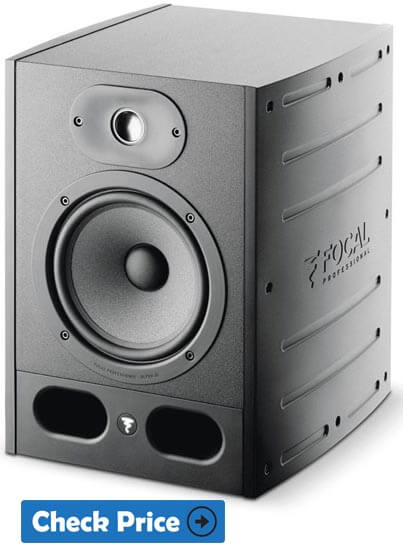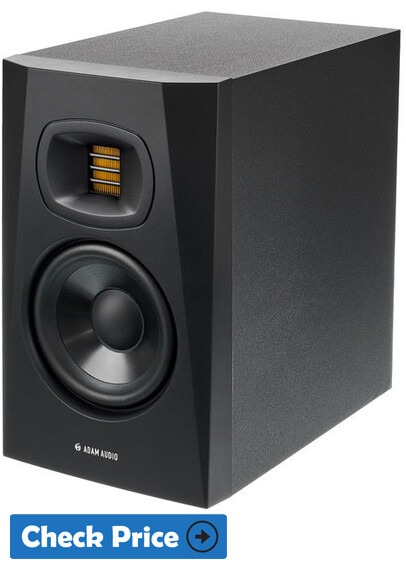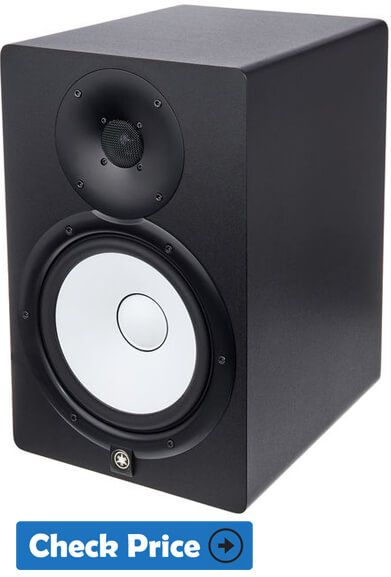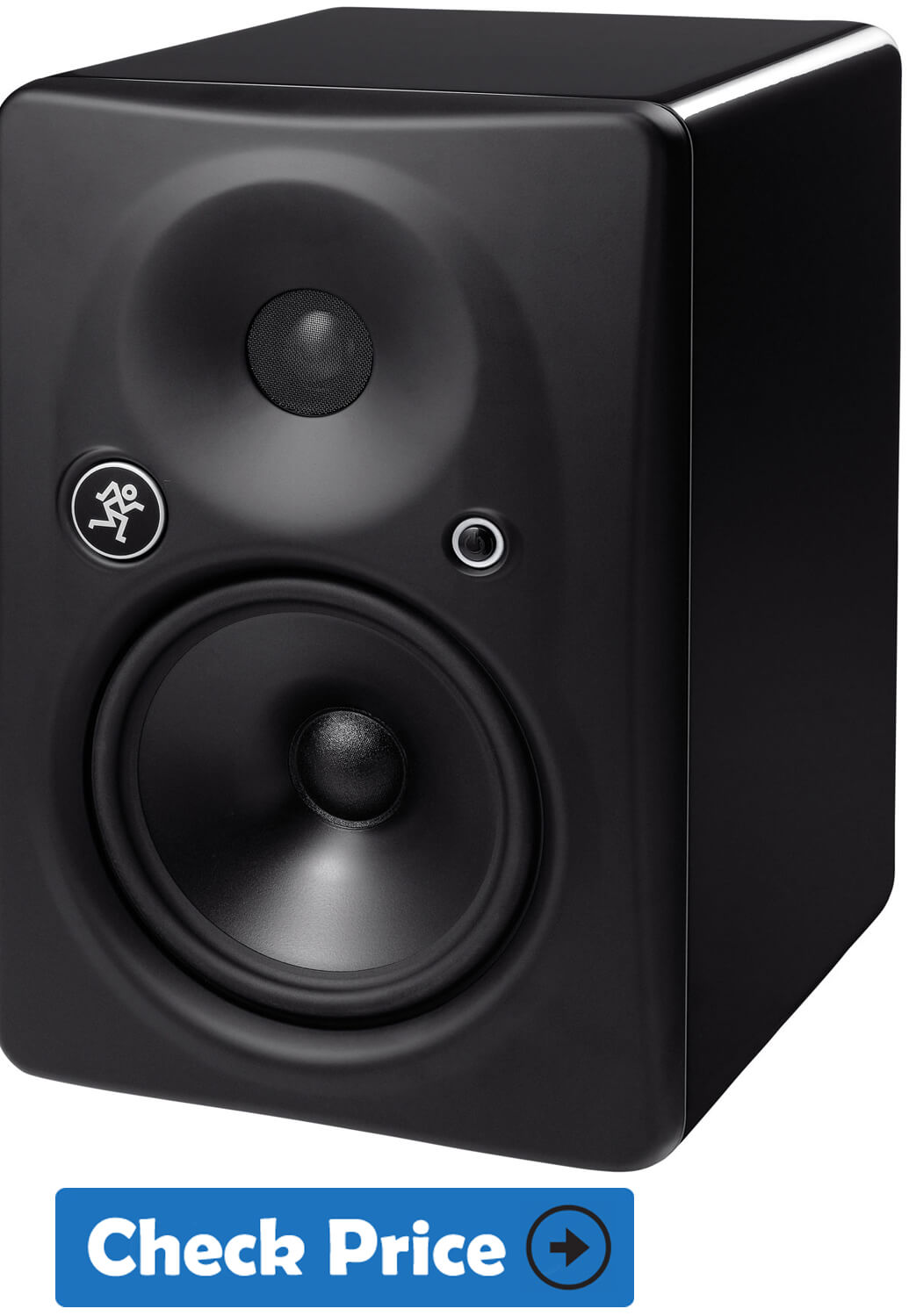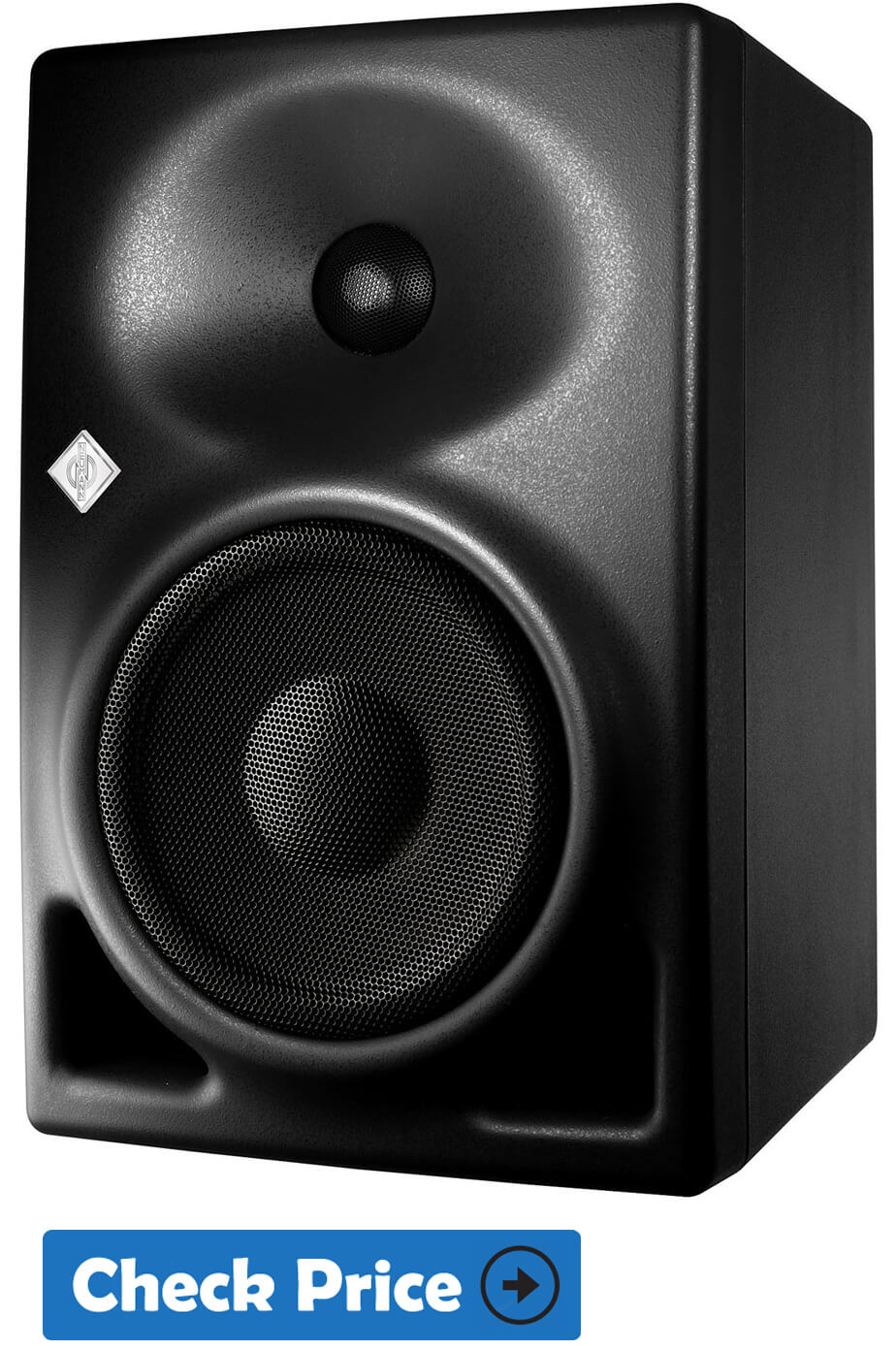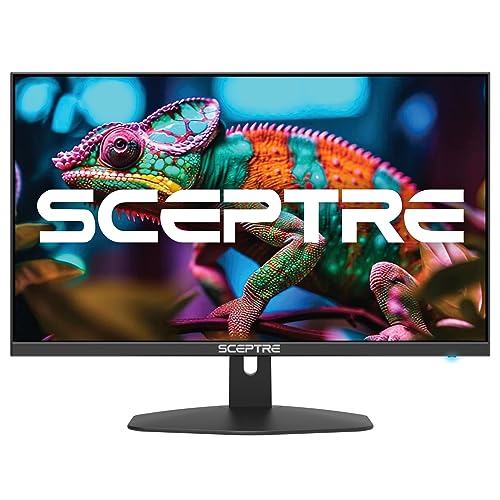Probably more than any other component of a recording studio’s equipment. The studio monitors are possibly considered as the most important tool to get a good sound.
That’s why large studios sometimes spend $ 1,000 or more on the best monitors available. And although that may be surreal for a home studio …
Best Studio Monitors Under $1000
Table of Contents
Finding the best studio monitors can be a challenge. What brand should I choose? What is the best type? What about size, weight, and material?
Don’t worry, we have simplified the process of buying studio monitors for you:
There are a large number of studio monitors available in the market today. With so many options, it is important that you take some time to learn more about the characteristics of each of them before choosing.
Also Read: Best Bluetooth speakers for an outdoor party
Here we advance your homework and we have prepared the list with the best studio monitors under $1000 :
Best Studio Monitors Under 1000 Dollars | 2025 Comparison Table
Top Quality | 5-Stars Rating | Under $1000
| Product Name | Wattage | Driver | Frequency | Price $$ |
|---|---|---|---|---|
| Focal Alpha 65 | 105W 2-way | 6.5" | 40 Hz - 22kHz | view on Amazon |
| Adam Audio A3X | 70 W 2-way | 5" | 45 Hz - 25 kHz | view on Amazon |
| Yamaha HS8 | 120 W 2-way | 8" | 38 Hz to 30kHz | view on Amazon |
| Genelec 8010A | 50 W 2-way | 3" | 67 Hz-25kHz | view on Amazon |
| Mackie HR624mk2 | 140 W 2-way | 6.5" | 49 Hz-20 kHz | view on Amazon |
| Presonus R80 | 150 W 2-way | 6.8" | 45 Hz – 22 kHz | view on Amazon |
| Neumann KH 120 A | 100 W 2-way | 5.25" | 52 Hz – 21 kHz | view on Amazon |
7 Top Studio Monitors Under 1000 USD| 2025 Products Overview
1 Focal 2x Alpha 65 Flattest Studio Monitors Under $1000
- Design: 2-way front-ported
- Woofer: 6.5” composite fiber
- Tweeter: 4” X-Art folded-ribbon
- Frequency response: 40Hz – 22kHz
- Wattage: 105 watt total (70 watt LF and 35 watts HF) Class
- A/B amplifiers
- XLR and RCA input jacks
- Weight: 20.7 lbs.
About:
The Focal alfa 65 is a very effective studio speaker for key monitoring and mixing. The undistorted neutral sound remains unchanged throughout the control room. If you are an electronic sound producer, it is highly recommended that you use a studio monitor.
Connect up to two audio sources via XLR and RCA inputs. At low volume and high volume, the sound balance is the same and there is no reflection on the wall. These two technologies provide a neutral sound throughout the studio. In addition, energy consumption is very low.
Driver
The Focal 2x Alfa 65 is equipped with a low-frequency driver with a 6.5″ polypropylene cone and reverse 1″ aluminum dome tweeter. This combination can provide the best sound for your project.
The 6.5-inch mid-range speaker is a great choice for home studios.
Wattage
Built-in amplifier because it is an active two-way monitor. This class AB amplifier provides 105 W of power output. Since this monitor is a 2-way monitor, the woofer and tweeter receive separate power from the amplifier. The bass power is 70 W and the tweeter power is 35W.
The amplifier can provide up to 106 dB of SPL (sound pressure level). The advantage is that the tone balance does not change even if the volume is increased or decreased.
Also Read: Best Amplifier Under 1000 USD
Near field or far-field
The Focal 2x Alfa 65 is a pure near-field studio monitor. You can use this monitor in your home office without any problems, and you can use this monitor to get a high-quality mix.
However, there is no acoustic adjustment switch. To adjust the sound to the size of the studio, you need to rely on the high and low shelf knobs on this display.
Since the 105W power is not large, the performance in a large acoustic processing room is poor.
Frequency Response
In the focus state, this display can provide frequencies from 40Hz to 22kHz. The bass is better than the other studio monitors listed here. In the same range, the kicker and bass line are mixed more accurately than other monitors.
I have not received any information about the crossover frequency of this monitor, but I think the bass output is about 2.2 kHz to 2.5 kHz. If the frequency response is between 2.2 kHz and 3 kHz, this is a good signal for this monitor because it makes it easy to mix vocals.
Environment
The Focal 2x Alfa 65 is a near-field monitor so it can be used in smaller rooms without much acoustic processing. In a near field monitor, the environment no longer affects the sound.
The second advantage of this display is that the bass reflex holes face forward, so you can safely mount them on the wall.
- Clear and powerful sound (105 W)
- Ideal for electronic music
- Sound balance does not change at high volume
- Unknown crossover frequency
2. Adam Audio T5V Studio Monitors Under 1000
- Design: 2-way front-ported
- Woofer: 4.5” composite fiber
- Tweeter:
- Frequency response: 45 Hz – 25 kHz
- 50 watt total (50 watt LF and 20 watt HF) Class
- A/B amplifiers
- XLR and RCA input jacks
- Weight: 10.1 lbs.
About:
For those who know it, ADAM Audio has caused a stir in the recording industry over the last decade because of its innovative design.
Using exclusive designs for tweeters, waveguides, and diaphragms, the company has established the format of professional studio recordings around the world. T5V wants to enter the market/research project in the housing and specialty market by offering the lowest price for ADAM.
Driver
ADAM Audio studio monitor driver benefits from years of in-house research and development and benefits from the latest developments in technology and materials science.
The T5V woofers are designed to deliver optimized low-frequency playback with extended dynamic range without color. It incorporates a low mass conductive cone of rigid polypropylene. A highly efficient set of magnets and a precisely aligned voice coil. Optimized chassis/basket design.
The 5-inch T5V woofer extends the response to 45 Hz. This makes the speaker a good option for close field monitoring in small control areas with or without a subwoofer. The AD8 Audio Sub8 and Sub7 subwoofers are fully integrated with the T5V.
Also Read: Best outdoor Wireless Speakers
Wattage
The T5V swivel panel features a rear bass reflector port mounted on a thick metal plate housing the analog input connections and the DSP controller junction and balancing. The Woofer 50 W Class D amplifier, in combination with the D 20 W class tweeter amplifier, allows a T5V pair to achieve a maximum SPL of 106 dB at 1 meter.
Extensive T5V frequency response, powerful dynamic range, exemplary transient response, wide sweet spot, and compact footprint make it ideal for use in small control areas for music production, video editions, and streaming applications. Given the discreet budget to be used in many installations, it is the perfect surveillance solution.
Frequency Response
The Tweeter U-ART Acceleration Tape amplifier uses a pleated diaphragm instead of producing a piston diaphragm like most speakers and prevents distortion by moving the air four times faster. Fold the fold.
Built with the toughest tolerances, the tweeter U-ART delivers extremely low distortion, extends the frequency range up to 25 kHz, enriches the sound field with amazing data, and delivers all shades of source material without acoustic fatigue.
- Ideal for home recording
- accelerated-ribbon tweeter
- Active Speaker (Plug & Play)
3 Yamaha HS8 Studio Monitors Under 1000 USD
- Design: 2-way front-ported
- Woofer: 8” composite fiber
- Tweeter: 1” X-Art folded-ribbon
- Frequency response: 38Hz to 30kHz
- 120 watt total (75 watt LF and 45 watt HF) Class
- A/B amplifiers
- XLR and TRS input jacks
- Weight: 28. lbs.
About:
The Yamaha HS8 studio monitor is one of the best studio monitors manufactured by one of the best companies in the music sector. Accuracy is the most important thing you want from a studio monitor and this Yamaha beast is pure precision.
Excellent near-field and small-sized monitors for home or studio, with the legendary Yamaha white cone. Unlike the studio monitors, which incorporate added frequencies for bass or treble and that can be more spectacular at the first listening, the HS series speakers have been designed as we said before to provide the most reliable and accurate reference possible, providing an ideal sound base throughout the mixing process.
The Yamaha HS8 introduces 8 drivers that produce a very sophisticated sound quality for mixing while providing an incredible listening feel in a typical stereo system.
High efficiency 1 "Silk Dome Twitter provides high quality and high-quality sound. Thick waveguide technology is used as a tweeter vibration minimizing device. The result is a smooth high end with no distortion.
Wattage
The Yamaha HS8 is equipped with a powerful independent bi-directional 120-watt amp dedicated to both the woofer and tweeter, providing accurate and distortion-free sound even at high volume. A precisely designed amplifier gives a nearly flat frequency response and makes the mix a masterpiece.
Frequency Response
The frequency response is the frequency intensity curve of the sound provided by the monitor. A flat curve is the ideal frequency response. In fact, it will be as flat as the frequency response curve, just like an exact mix.
The Yamaha HS8 offers a nearly flat frequency response curve that takes the mix to the next level. The beast provides frequency response from 38Hz to 30kHz.
The result is a direct one. Tight bass at just 38 kHz in the high range does not require touching or erasing up to 30 kHz. The 2 kHz crossover provides a clear and extremely flat midrange that is useful for audio mixing.
Environment
This is the only drawback to buying a high-power 8 "studio monitor. The Yamaha HS8 has an 8" woofer that uses the power of a 120 W dedicated amplifier. 10 “X8” pay it?
To use this monitor, you need a control room 12'X14 '' treated with at least semitones. Or you can choose a Yamaha HS5 specially designed for small rooms.
The Yamaha HS8 is a near field monitor. Near field monitors are commonly used for mixing. HS8 works well when installed 2-4 feet away. Beyond this distance, the sound begins to disperse and the accuracy decreases.
- Large 8-inch woofer and high-voltage amplifier provide excellent sound
- ability to reduce unwanted noise
- Narrow base with clear mid and high frequencies
- Good frequency response with a nearly flat frequency curve
- Sturdy construction lasts longer
- Bass slightly interferes with midrange
- Not for beginners
4 Genelec 8010A An extremely small studio monitor
Key Specifications
- Design: 2-way front-ported
- Woofer: 3” composite fiber
- Tweeter: 4” X-Art folded-ribbon
- Frequency response: 67Hz-25kHz
- 50 watt total (25 watt LF and 25 watt HF) Class
- A/B amplifiers
- XLR and RCA input jacks
- Weight: 3.3 lbs.
About:
Genelec is usually a trademark trusted by many professionals and used in many high quality studios. Fortunately, they have been on the market for less than $ 1000, giving you the opportunity to know what professionals are using, even in a small package.
Speaking of small size, this powered surveillance studio has a small 3 "woofer and 0.25" tweeter, which makes the volume lower and lower than expected with large speakers. This is why many users combine with studio subwoofers.
Apart from volume constraints, moderate clarity is very useful in small home learning situations. It is also an ideal portable solution for those who want to have a studio monitor.
Also Read: Best Sound bar under 150 USD
Driver
Wattage
The amplifier uses the GENELEC smart signal detection circuit to save less than 0.5W in standby, less than 5W during idle and 30W peak per amplifier at full power. The amplifier automatically detects the presence of the input signal and adjusts the power of the display accordingly.
Frequency Response
The display uses GENELEC waveguides and a minimal diffraction design to reduce box reflections, flatten the frequency response from 74 Hz to 20 kHz, and provide a maximum SPL of 96 dB.
Environment
The bass tilt control lets you adjust the bass response to the listening environment of the listening environment. With ISO support provided, desktop vibration transmission can be reduced.
- Minimum diffraction enclosure (MDE) ensures low-distortion performance
- clean mids and highs
5. Mackie HR624
- Design: 2-way front-ported
- Woofer: 6.5” composite fiber
- Tweeter: 4” X-Art folded-ribbon
- Frequency response: 49Hz- 20kHz
- 140 watt total (100 watt LF and 40 watt HF) Class
- A/B amplifiers
- XLR and RCA input jacks
- Weight: 21 lbs.
About:
Perhaps you know Mackie as an analog and digital mixer manufacturer. However, you will also create other professional audio articles such as studio monitors and audio interfaces.
The Mackie HR624 is a mid-range mid-range monitor that costs about $ 1000. This studio monitor gives you all the features you need for good monitoring and mixing. Because there is a back button for sound adjustment, it can be adjusted in all environments.
Also Read: Best Bookshelf Speakers Under 1000
The integrated attenuation function provides a noise-free sound that removes mid-range artifacts. The passive radiator provides a narrow and clear bass range of up to 45Hz. This is very low compared to the Neumann KH120 A, which is more expensive than this monitor.
This monitor is THX pm3 certified for surround sound and is ideal for high-resolution audio, games, and movies.
Driver
The Mackie HR624 is equipped with a high-precision, low-distortion 6.7 ″ LF transducer that provides accurate low frequencies up to 45 kHz. 1-inch titanium tweeter cooled with magnetic fluid is the best Provides a very accurate mid-high frequency of 22 kHz.
Mackie HR624 is built with a passive radiator function that replaces the port in other speaker systems. The advantage of passive radiators is that when the sound pressure level is high, SPL can reproduce low frequencies with lower distortion than other simple ducts.
Watt
The Mackie HR624 features two FR amplifiers of 140 watts (100 W at LF / 40 W at HF) and delivers superior sound with up to 89 dB SPL sensitivity. An active crossover and time correction circuit are built into the amplifier so that the treble and treble reach the ear simultaneously.
The amplifier is also equipped with a protection circuit to protect against harmful input levels.
This monitor is designed with a one-piece die-cast aluminum zero-edge baffle that minimizes diffraction and provides a clear image of the mix.
The front power button also functions as an overload indicator, indicating that the monitor is overloaded.
Far or Near Field
This is a pure near field monitor and is a good option for homes and small recording studios. In addition to the low cut, medium, and high cut switches, there are acoustic adjustment switches.
Therefore, this monitor can be used in a soundproof room. It can be adjusted according to the size and room environment.
Frequency Response
The low-frequency transducer provides a frequency range of 45 Hz to 6 kHz, and the high-frequency tweeter provides 1.6 kHz to 22 kHz. Get the sound from 45Hz to 22Khz. The frequency curve is almost flat at ± 3 dB, which is another advantage of the mix.
The crossover frequency is about 3 kHz, slightly higher than other speakers in the same range. Boosts the mid-high range, such as female vocals.
Environment
This monitor speaker can be adjusted in any environment. Equipped with an acoustic switch. Low cut, high cut, and medium-cut switches make you comfier in any environment.
Here are the pros and cons of the Mackie HR624. These will help you make a purchase decision.
- Clear and powerful sound (140 W amp)
- Compact design
- Passive radiators provide clear bass.
- Zero edge aluminum deflector minimizes diffraction
- Sound adjustment button
- Expansive
- Bit high crossover
6 Presonus R80 Great Studio Monitors For $1000
- Design: 2-way front-ported
- Woofer: 6.8” composite fiber
- Tweeter: 4” X-Art folded-ribbon
- Frequency response: 45 Hz – 22 kHz
- 150 watt total (100 watt LF and 50 watt HF) Class
- A/B amplifiers
- XLR and RCA input jacks
- Weight: 19.8 lbs.
About:
The R65 features a 6.8 square inch custom Air Motion Transformer (AMT) tweeter that responds to major waveforms and high frequencies. This allows you to hear the “air” that characterizes the recording and the sense of the larger space.
The R65's transparent and precision sound is ideal for use in broadcast and post-production environments as well as commercial and domestic recording studios.
Also Read: Best Floor Standing Speakers Under
Driver: The Presonus R80 is equipped with an 8-inch Kevlar woofer and ribbon tweeter. The combination of these two high-performance technologies provides a clear sound. Suspended by an electromagnetic field that responds at the thinnest part of the frequency.
Thanks to this 6.8-inch Air Motion Transformer (AMT) tweeter technology, you can get a clearer sound quality. This feature makes this Presonus R80 ideal for mixing.
In addition, the 8 "Kevlar corn woofer adds bass at just 40Hz.
Watt
The Presonus R80 has a 150-watt 2-way amplifier in each piece. This 2-way amplifier is specially designed to provide accurate power to the woofer and AMT. The power distribution to the woofer and tweeter is 100W and 50W respectively.
Class D power amplifier with switching power supply, output current limit, RF interference, overheating, subsonic filter protection, transient on / off. Gets the power saving mode that reduces power to <0.5W in standby mode.
Frequency Response:
An almost flat frequency response of 40 Hz to 22 kHz is obtained. Although not as much as the Yamaha HS8 offers, it is enough for a good mix. The frequency of 40Hz is very low and easily corresponds to bass and battery. In addition, the high frequencies cover the range beyond the human audible range, which is incredible. The almost flat frequency curve makes it an ideal monitor for mixing.
If you are an expert mixing engineer, you will find that balancing the human voice is the most difficult part of a mixing session. The Presonus R80 provides a 2.6 kHz crossover frequency. The frequency of human voices. A very good midrange is obtained, and as a result, the sound can be mixed more accurately.
Features
This studio monitor is perfectly close to the field and has acoustic space settings (linear, -1.5 dB, -3 dB, -6 dB) to correct the position of the room. This is very useful when the control room is not receiving much acoustic processing.
As you know, the near field monitor is perfect for sound mixing. This monitor is a good option if you need a monitor for mixing. Remember that you are using an AMT ribbon tweeter. This is another advantage of mixing this monitor.
This monitor has an 8-inch woofer and a 150-watt amplifier but perfectly fits a large control room. Do not be disappointed. The acoustic space settings (linear, -1, 5 dB, -3 dB, -6 dB) are behind the monitor.
- 6.8 inch AMT ribbon tweeter responds to the thinnest frequencies
- Compact dimensions
- High & detailed frequency
- Adjustment knob for placing the room
- The price is very competitive
- Not ideal for small room size
7 Neumann KH 120 A Best Budget Studio Monitors (Single)
- Design: 2-way front-ported
- Woofer: 5.25” composite fiber
- Tweeter: 4” X-Art folded-ribbon
- Frequency response: 52 Hz – 21 kHz
- 100 watt total (50 watt LF and 50 watt HF) Class
- A/B amplifiers
- XLR and RCA input jacks
- Weight: 17.5 lbs.
About:
Neumann KH 120A: This is one of my favorite studio monitors in the top ten. Neumann is a famous brand of microphones and condenser monitors.
Using Neumann's vocal condenser microphone, I was amazed at the clarity of the sound each time I recorded sound with these microphones.
The Neumann KH 120A studio monitor has the same outstanding sound quality. Having this monitor means perfect recording and mixing sessions.
Driver
The Neumann KH 120A is equipped with a 5.25-inch long subwoofer that is mounted under the metal grill for extra protection. The internal model composite long corn bass sandwich controller built with ELFF power factor technology is very linear and provides the best mid-bass for the highest quality. Linear piston motors help provide very low harmonic distortion even at high offsets.
The 1-inch alloy fabric dome tweeter is made using the latest modeling techniques to minimize nonlinear distortion while providing precise high frequencies.
Moreover, the woofer and tweeter are magnetically protected. In other words, even if the monitor enters the magnetic field, the sound will not be affected.
Wattage
The power is not as high as the first three displays. However, amplifiers with 50 watts + 50 watts of bi-amps are ideal for the 5.25-inch woofer. Since the tweeter was found to have the same power as the woofer, it is clear that the tweeter is more powerful than other high power speakers. It can provide more accurate sound at medium and high frequencies.
Larger rooms don't have much power, but medium-sized rooms offer excellent sound and image segmentation.
The studio monitor is ideal for unconventional mixing.
Near field or far-field
This is a near field monitor that is ideal for small to medium-sized environments. There are three switches on the back that adjust the low, medium, and high range depending on the size and environment of the room.
The reflection of the front two-way bus is more ecological. In addition to the bass reflex rear monitor, these sounds do not affect the rear environment. Many reflections are not available from the back wall.
Near field, monitors are ideal for mixing. With the Neumann KH 120A, you can take your project to the next level.
Frequency Response
The Neumann KH 120A typically provides a frequency response of 52 Hz to 21 kHz at ±3 dB and a frequency response of 46 Hz to 24 kHz at ±6 dB.
Due to the low-frequency range of 52 Hz, it is difficult to provide perfect bass. Speaking of the general frequency range, it is a perfect studio monitor.
High frequencies are beyond the reach of humans, so you can get all the frequencies of a high-quality mix.
The main magic is its frequency curve. Its frequency curve is flatter than many displays in the same range. And you know how important a flat frequency curve is for a good mix.
The crossover frequency is about 2.0 kHz, so you get the perfect vocal and midrange frequencies for mixing.
Environment
The 5.25-inch, 100W display features low, medium, and high adjustment buttons so you don't have to worry about using it in your home office.
If you need a high-end mid-size studio monitor that can adjust the environment, be sure to choose the Neumann KH 120A.
Because of its ability to provide a flatter frequency response, many studios have this studio monitor.
- provides very accurate and delicate sound
- frequency curve is flatter
- Excellent manufacturing quality
How to Choose Best Studio Monitors Under $1000 | Unrivaled Guide 2025
There was a time when the concept of home recording was not really the big deal, but gradually the potential of home studies has grown a lot. There are several things that will be needed in a home studio to get quality recordings. One of the most important things is a monitor or a pair of studio monitors. What is important about studio monitors? The answer is simple.
To produce good music or record high-quality sounds or voices, a studio monitor is needed. They are essential for recording and mixing, as they allow you to hear the sound as it is recorded.
There are some important things to keep in mind when buying a studio monitor. Here are the basics so you know what to look for when you arrive at the store.
Studio Monitor Design
The design of the monitor must be robust and compact. Here you will learn not only aesthetics but also the design and construction of the cabinet. After all, an office is more than just a home converter. You can use the best controllers, but that makes no sense unless the cabin is designed to complement them.
Frequency Range
This determines the frequency range the monitor can handle and is usually directly related to the size of the HF and LF controllers. Wider frequency response can handle more types of music, but these additional frequencies can be compromised and lose important audio details.
If you prefer mainly electronic or DJ music, you'll need a larger monitor that can handle the lower overall frequencies typically associated with these styles.
On the other hand, when using acoustic instruments and acoustics, it is advisable to opt for a flat-panel studio monitor because the excessive bass cannot mix properly and balance the frequencies. It is highly recommended to use multiple monitoring groups. This allows you to use more audio reports.
Wattage
Watts is the nominal power of the studio monitor. This is important because of the higher the nominal power, the greater the headroom and the volume you will get with your studio monitor.
Environment
The type of speaker you choose depends on the mixing environment. If you are not handling the room (such as a bedroom or a home studio), it is advisable to select a small monitor and use a headset to check the low-frequency balance. Untreated rooms tend to bounce off the sound and have imbalances that affect the perception of frequency levels. Large loudspeakers can cause a phenomenon called "standing wave" in a space with parallel walls.
Depending on where you are in the room, this effect can cause low frequencies to bloat in one place or disappear altogether. You can use a carpet as an extractor, irregular surfaces as shelves and almost flat walls as a diffuser, but if you are not planning to fully treat the room, use speakers with a 5-inch or less woofer.
Size of Studio Monitor
Another important consideration is the size of the speaker or the size of the woofers. Simply put, the bigger the woofer, the better it will produce serious sounds and vice versa. A larger woofer also means that your studio monitor will be larger in general, so if space is a problem, you'll want to keep it in mind.
Here is an example. If we look at two woofers of different sizes, one of 8 ″ and another of 5 ″, the bass you would get from the 8 ″ subwoofers will be much better than the ones you would get from the 5 ″.
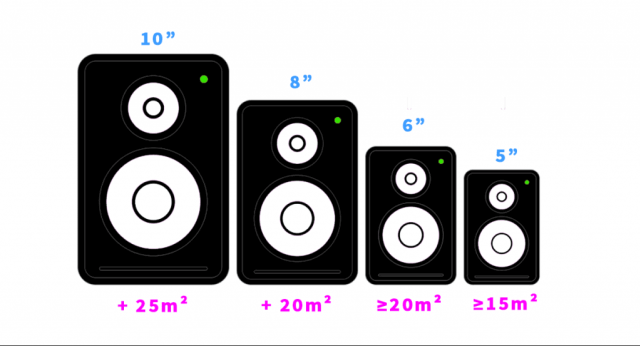
Weight
Studio monitors come in different weights. It is useful to know the size and weight of the models that interest you before spending money.
Types of Studio Monitors
There are two types of study monitors, liabilities and assets. Passive monitors are not equipped with an amplifier, so you will have to buy an amplifier separately to turn them on. Active studio monitors are equipped with a built-in amplifier so you can use them directly from the start without having to make more purchases. In terms of what is best, it is completely a matter of personal preference.
Active Monitors vs. Passive Monitors
Now, this is the most important consideration to consider when buying a studio monitor. Passive studio monitors are simply speakers without power; To turn them on, you will have to buy external amplifiers. Active studio monitors have a built-in amplifier so you can use them directly from the box. Both are good, this is rather a matter of personal preference.
Crossover
The crossover is an electronic circuit that is responsible for dividing the frequency content of the signal using filters so that each of the speakers/drivers receives the frequency content that is capable of reproducing without problems.
The crossovers divide the signal then according to the number of pathways required by the monitoring system. Consider that crossovers modify the phase of the signal and are one of the most delicate aspects of speaker design.
Drivers
They are the generators of sound and we will find them in two types according to the range of frequencies they reproduce. The low-frequency driver is called woofer and the high-frequency driver tweeter.
Woofer
It is the largest and is responsible for reproducing low frequencies because to emit these frequencies it is necessary to displace large amounts of air.
Woofers have to be light but stiff to be able to move as much air without deforming. For that reason, we will find that they are made of materials such as paper, paper coated with other protective materials, kevlar, polyglass, among others.
The size of the woofer determines the lower frequency response limit of the monitor. In practice, and in the context of the home studio, we will find models with woofers ranging from 4 to 8 inches in diameter.
Tweeter
It is the speaker that emits high frequencies. It is usually of small dimensions compared to the woofer, since it has to move quickly to generate these frequencies.
It must be light and can move quickly. To achieve these goals, hard materials such as aluminum, titanium, beryllium or soft materials such as silk or other fabrics are used.
Both materials and types of tweeter have their defenders and detractors, however, a large part of its proper functioning depends on the design and implementation of the driver, since there are examples of good quality in both alternatives.
Compensation circuits
Today, most near-field monitors have circuits to compensate for the position of the monitors inside the room and some acoustic problems.
Access to these circuits is usually at the rear and can be activated or deactivated according to the user's needs. Let's look at some of the most common alternatives:
- LF Control: attenuates or enhances low frequencies with a shelving curve to compensate for the proximity of the monitor to a nearby wall.
- HF Control: attenuates or enhances high frequencies with a shelving curve to compensate for excess low frequencies or very absorbent rooms.
- Desktop notch: allows you to compensate for the reflection of the desk or table on which the monitors are located.
Monitors vs. Speakers
How To Choose The Right Monitors For You
FAQs
What are studio monitors and why do you need them?
The monitors are specially designed to serve a particular purpose: to monitor the sound during a recording.
Now we will move on to the second part of the question. Consider a group of 100 people who come to the market in search of speakers. There is a high probability that 98 of these 100 people buy standard consumer speakers since they want the speakers simply to enjoy the music.
The consumer speakers are equipped with sound reinforcement functions that modify the actual sound to enhance the listening experience. The monitors are used by professional musicians because they reproduce or emit the authentic sound without coloring the music (or recording) in any way.
The idea behind this process is that if a musician is able to make mixes or recordings that sound good on studio monitors, it is most likely that when this mix or recording is being heard by a consumer, it sounds excellent.
What is a ribbon tweeter?
Ribbon tweeters use the same mechanism as ribbon microphones. Ribbon tweeter controllers often consist of aluminum deposition that is several times thinner than a dome tweeter controller. This incredibly light and very flexible controller is suspended in an electromagnetic field.
With an extremely thin controller, the ribbon tweeter responds to the thinnest waveform. What makes them incredibly acceptable, dynamic and detailed.
How do I place my studio monitors?
First, position the monitor as far away from the walls and corners as possible. Placing acoustic foam on the wall both behind the speakers and behind the listener can reduce the reflections of the rooms and make the listening environment more precise. The most important thing is to place pairs of stereo monitors on the head and an equilateral triangle.
What’s the “Sweet Spot”?
The speakers must be at the same distance from each other and place their heads in the so-called sweet spot. Also, the loudspeaker of the speaker should be positioned perpendicular to the ear. Use a pair of studio studios to position your speakers at the right height.
Do I need a studio monitor subwoofer?
There is a reason to use low-frequency speakers in live music venues. Of course, the main studio monitor can play frequencies up to 20 Hz (or lower), but we forget that low-frequency playback requires much more power than medium and high-frequency playback. Please no. It is more efficient to dedicate the subwoofer to the subwoofer bass (less than 100 Hz) and release the main stereo display to reproduce the mixed bone marrow.
The extended subwoofer studio frequency range is useful for precise tracking, assuming control of where the center stereo monitor is located.
Conclusion
So this was all about the best studio monitor under $ 1000. In my opinion, they are all gems. Now the choice is yours. I've published all the details of these screens in the post. After reading this article, you can choose the best screen for your research.
Which monitor will you buy? Don't forget to let our readers know. Comment below. Help the reader choose the best from the list.
